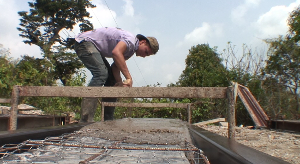Cuba: rapid recuperation after the disaster
 Fifteen days after hurricane Ike, almost anywhere in Cuba one feels the enormous effort to reestablish normality. Almost half a million houses were damaged and more than 100’000 collapsed totally. Everywhere one can see people repairing roofs and placing fibrocement elements (similar in shape to asbestos-cement).
Fifteen days after hurricane Ike, almost anywhere in Cuba one feels the enormous effort to reestablish normality. Almost half a million houses were damaged and more than 100’000 collapsed totally. Everywhere one can see people repairing roofs and placing fibrocement elements (similar in shape to asbestos-cement).
Almost the whole country has electric energy, although more than 140 towers of the primary power lines and thousands of posts collapsed with “Ike” and “Gustav” who passed through the province of Pinar del Rio and the Isla de la Juventud a few days earlier with winds of up to 345 kmh.
The Cuban state assumes basic costs of reconstruction after disasters, facilitating construction materials to the population. The companies and ministries give time off (with salary) to the affected people so they can repair their homes. It is clear that in a catastrophe of this dimension the real possibilities cannot cover the demands. Nevertheless, in all the affected communities there are distribution points where materials such as wood, fibrocement elements and nails are being handed to the population. On the road from Holguin to Santa Clara we saw a caravan of approximately 30 trucks filled with materials.
Visiting the most affected provinces we where able to classify the effects on the roofs in three groups:
- Heavy roofs like concrete slabs and brick vaults in their majority did not suffer damages.
- The clay- and micro concrete tile roofs presented “small” damages with some exceptions where the damages are greater, as did organic roofing.
- The fibercement sheets and metal sheets presented almost a 100% of damage in the most affected areas.

The vice-president of the town of Banes said: “You know that I was critical back then when you started the micro concrete tile production, but after “Ike” I am glad for this solution, the MCR resisted a lot better than the fiber sheets”.
The Swiss government has decided to concentrate its efforts of reconstruction through CIDEM, founding member of the EcoSur Network, providing EcoMaterials production facilities to seven municipalities. These workshops are being equipped with block machines, mills for alternative cement, tevi equipment to produce micro concrete tiles, equipment to produce ferro cement walling elements and equipment to produce concrete beams. CIDEM advises these workshops, in addition to the 22 already existing workshops in the country. Grupo Sofonias organizes together with SofoNic the importation of the equipments and some technology transfer.
The national housing institute recommends that other donors apply the same methodology and Fernando Martirena receives many requests to discuss possibilities.
These actions of EcoSur colleagues concentrate themselves around a medium to long term strategy: “Create physical capacity so that each municipality can respond rapidly to disasters. One seeks to provide each family with at least one small unit, that can expand later as a progressive house”. In the future one seeks that each municipality has some ferro cement modules in stock to be able to build up the units rapidly.
Even though this strategy is for a medium time range, the actions of CIDEM are among the most advanced and probably the first to be producing in new workshops.



